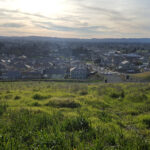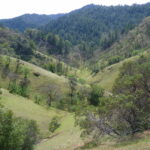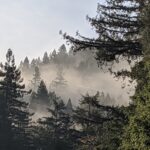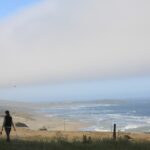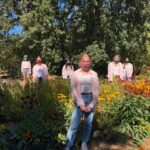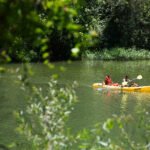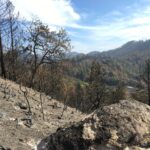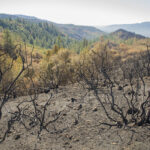January 27, 2021
Posted in: News Articles
A year in review: Highlights from 2020
As we reflect on the last year we find ourselves full of gratitude for our amazing Sonoma County community. Every day, we strive to thank you all through our work – protecting the natural and working lands of Sonoma County. As 2021 begins, we took some time to reflect on our accomplishments over the last year – and none of this would be possible without you!
Watershed moments
- We finalized the Vital Lands Initiative and sent it to our Board of Directors for final approval (approved January 26, 2021!). Over the past few years, we have worked with the community and our colleagues to develop a shared vision and strategy for the future of land conservation in our region – one that places a premium on climate change resiliency and social equity, while continuing to conserve our most vital natural and working lands.
- After eleven years, our long-time General Manager Bill Keene left Ag + Open Space to pursue his next adventure working at the intersection of climate change, equity, and affordable housing. While our Board of Directors leads a search for our next General Manager, we are lucky to be led in the interim by Caryl Hart. Caryl’s extraordinary contributions locally and throughout California precede her, and she shares her vision for her time with Ag + Open Space here.
Landmark conservation projects
- In March, we finalized the 54-acre Cooper Creek Addition to Taylor Mountain Regional Park and Open Space Preserve, a crucial step in supporting future greenways and trails that could connect to other regional and state parks in and around Santa Rosa. Made possible through our partnerships with the Sonoma Land Trust and Sonoma County Regional Parks, Ag + Open Space contributed $742,000 of the $1.35M dollar investment to protect this critical property forever.
- In May, we purchased a conservation easement on the magnificent 3,364-acre Gloeckner-Turner Ranch along Rockpile Road near Lake Sonoma. This property is home to a network of wildlife corridors, and also hosts the headwaters of the Wheatfield Fork of the Gualala River and Rancheria Creek, which run south into Lake Sonoma. The ranch, which has been in the Gloeckner-Turner family for decades, is now protected thanks to combined contributions from the family itself, Ag + Open Space, Sonoma Land Trust, Sonoma Water, and the Gordon and Betty Moore Foundation. The Gloeckner-Turner family offered a $4.44 million discount – nearly half the value of the easement – while Ag + Open Space contributed $4.5 million in public funds toward the total purchase price of $5.015 million.
- In October, we helped Regional Parks acquire the Torr property, which will be a new 515-acre Regional Park and Open Space Preserve near Monte Rio. Ag + Open Space’s $2.1 million contribution went toward acquisition of the westernmost 315 acres of redwood forest on this fantastic property. Going forward, Ag + Open Space will also provide funding for initial public access, operations, and maintenance for the next three years. This acquisition conserves significant biodiversity and will provide public recreation in a part of our county that is considered “park poor” by the State of California.
- And to wrap up the year, in December we transferred Carrington Coast Ranch, a stunning 335-acre property, to Regional Parks. These lands will eventually open to the public as a Regional Park and Open Space Preserve along the Sonoma Coast, just north of Salmon Creek. The ranch is primarily open grassland, which affords spectacular views of the ocean, while also sequestering carbon to help mitigate the effects of climate change, ensuring this area will adapt to sea level rise. It’s also home to several special status species, like the Townsend big-eared bat, California red-legged frog, and American badger. The future park will incorporate a critical portion of the California Coastal Trail.
Supporting education, agriculture, and urban open space through the pandemic
- After signing new three-year contracts with our Public Outings + Youth Education program partners at the very beginning of the COVID-19 pandemic, we completely re-designed the program to offer free virtual field trips, public outings, panel discussions, and interactive family events. Additionally, our partners are distributing lesson plans to teachers, hosting materials for families to access online, and sharing recordings of live content to increase accessibility and remove barriers.
- In response to the pandemic, we created the Agricultural Support and Protection (ASAP) Emergency Grant program in September to help Sonoma County farmers and ranchers affected by COVID-19 keep agricultural lands productive. We’re currently developing recommendations to the Board for projects to fund, and are anticipating releasing a second call for funding requests soon.
- As the pandemic carried on, we extended the application period for another round of our Matching Grants Program. We received nine applications, and are currently working with staff, our Advisory Committee and Fiscal Oversight Commission, and our Board to award grants.
Wildfire resilience work
- We continued our work with landowners, community partners, and government agencies to best prepare for, respond to, and recover from wildfires. We worked closely with landowners impacted by the 2020 LNU Lightning Complex and Glass Fires, and prioritized and implemented ongoing fuels reduction and healthy ecosystem management activities on all Ag + Open Space-owned properties. We continued our post-2017 fires recovery work on our Dogbane and Calabazas Open Space Preserves with vegetation management through workdays and grazing, and implemented a shaded fuel break on Calabazas where we also hope to have a prescribed burn in 2021, as conditions allow. After the Glass Fire burned a significant portion of Saddle Mountain Open Space Preserve, we began work with CalFire to remove sediment from creeks, address firebreaks, cleanup toxins, and coordinate with PG&E to remove hazardous trees. We also contributed to the local Watershed Task Force by analyzing how the Glass and Walbridge Fires affected our lands so we can help part agencies implement erosion control in the lead up to winter rains.
- Since the 2017 fires, our in-house GIS experts have been collecting and analyzing vast amounts of data to understand how those wildfires impacted vegetation. We’ve been sharing these findings with local government agencies, land conservation organizations, and in December, a study led by our staff was published the California Department of Fish & Wildlife Special Fire Issue. This study can now be our baseline for how different types of vegetation respond to fire over time, which will help all of us better understand the overall health of these forest ecosystems and their resilience in the face of future wildfires.
We are excited and energized as we begin our work in 2021!
